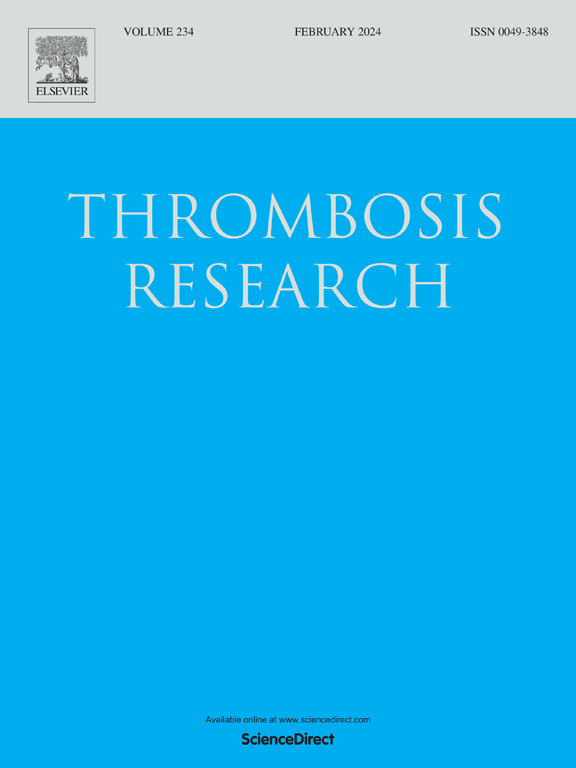Development and validation of an in vitro model to study thrombin generation on the surface of catheters in platelet-poor and platelet-rich plasma
IF 3.7
3区 医学
Q1 HEMATOLOGY
引用次数: 0
Abstract
Introduction
Coagulation activation on medical devices remains a significant problem as it can lead to dramatic thromboembolic complications. Understanding its poorly described mechanisms and finding optimal pharmacological prevention means is crucial to improve patient safety.
Methods
We developed an in vitro model to study thrombin generation (TG) initiated by the contact of plasma with the surface of catheters. Interventional cardiology catheters were cut into segments and inserted in the bottom of multi-well plates; TG was then measured with the calibrated automated thrombogram (CAT). Model performance (analytical, intra- and inter-individual variability) was investigated and compared with activation of thrombin generation by tissue factor (TF) or contact pathway activator (ellagic acid), in the presence (PRP) and absence (PPP) of platelets. Model response to unfractionated heparin (UFH) was also assessed.
Results
TG was greater when measured in presence of catheter segments, compared to conditions without activators. The analytical variability of the model was good (CV ≤ 5 %), both with PPP and PRP. Intra-individual variability was between 15 and 30 % with PPP and between 10 and 15 % with PRP. Inter-individual variability was between 15 and 30 % with both kinds of plasma samples. The analytical performance of the catheter-initiated TG model was equivalent to that observed when TG was initiated with TF or ellagic acid. Catheter-initiated TG was measurable until 0.1 IU/mL UFH with PPP and until 1.0 IU/mL UFH with PRP, highlighting the crucial requirement of platelets.
Conclusion
Our model is suitable for studying TG initiated with catheters. Inhibition of TG by UFH is overestimated in the absence of platelets.
开发和验证体外模型,研究贫血小板血浆和富血小板血浆中导管表面凝血酶的生成。
导言:医疗器械上的凝血活化仍是一个重大问题,因为它可能导致严重的血栓栓塞并发症。了解其描述不清的机制并找到最佳的药物预防方法对于提高患者安全至关重要:我们建立了一个体外模型,研究血浆与导管表面接触引发的凝血酶生成(TG)。将介入心脏病学导管切成一段段,插入多孔板底部;然后用校准自动血栓图(CAT)测量凝血酶生成量。研究了模型的性能(分析性、个体内和个体间变异性),并与血小板存在(PRP)和不存在(PPP)时组织因子(TF)或接触途径激活剂(鞣花酸)激活凝血酶生成的情况进行了比较。还评估了模型对非分数化肝素(UFH)的反应:结果:与没有激活剂的情况相比,在有导管段的情况下测量的 TG 更大。在使用 PPP 和 PRP 时,模型的分析变异性良好(CV ≤ 5%)。PPP 的个体内变异性在 15% 到 30% 之间,PRP 的个体内变异性在 10% 到 15% 之间。两种血浆样本的个体间差异在 15% 到 30% 之间。导管启动 TG 模型的分析性能与使用 TF 或鞣花酸启动 TG 时观察到的性能相当。使用 PPP 时,导管引发的 TG 在 0.1 IU/mL UFH 之前和使用 PRP 时在 1.0 IU/mL UFH 之前都是可测量的,这凸显了血小板的关键作用:结论:我们的模型适用于研究导管引发的 TG。结论:我们的模型适用于研究导管引发的 TG。在没有血小板的情况下,UFH 对 TG 的抑制作用被高估。
本文章由计算机程序翻译,如有差异,请以英文原文为准。
求助全文
约1分钟内获得全文
求助全文
来源期刊

Thrombosis research
医学-外周血管病
CiteScore
14.60
自引率
4.00%
发文量
364
审稿时长
31 days
期刊介绍:
Thrombosis Research is an international journal dedicated to the swift dissemination of new information on thrombosis, hemostasis, and vascular biology, aimed at advancing both science and clinical care. The journal publishes peer-reviewed original research, reviews, editorials, opinions, and critiques, covering both basic and clinical studies. Priority is given to research that promises novel approaches in the diagnosis, therapy, prognosis, and prevention of thrombotic and hemorrhagic diseases.
 求助内容:
求助内容: 应助结果提醒方式:
应助结果提醒方式:


